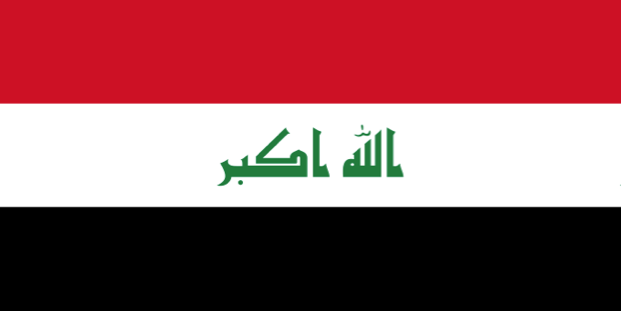Iraq’s political and security situation is unstable as the country continues to experience sectarian tensions (conflict between Shia and Sunni Muslims in addition to Kurdish groups), as well as armed violence in neighbouring countries. It has been involved in an armed conflict against the Islamic State group since January 2014, as well as an armed conflict with Turkey due to the country’s use of force against Kurdish militants in northern Iraq.1 The continued fighting against non-state armed groups contributes to instability and affects arms flows.2 Due to this instability and past conflicts, Iraq also has very high levels of landmine contamination.3
Conflict Armament Research (CAR) and the Small Arms Survey are working on the ground to support the through-life management of ammunition, in collaboration with the Iraqi Ministry of Defence. Efforts have included developing frontline evidence collection capacities and disarmament, demobilisation and reintegration (DDR) programmes, as well as physical security and stockpile management training.
1 “Iraq,” Rule of Law in Armed Conflicts Project (RULAC), Geneva Academy of International Humanitarian Law and Human Rights, updated March 13, 2019, https://www.rulac.org/browse/countries/iraq.
2 “Instability in Iraq: Global Conflict Tracker,” Council on Foreign Relations, accessed July 21, 2022, https://www.cfr.org/global-conflict-tracker/conflict/political-instability-iraq.
3 “Halo Starts Work in Iraq,” HALO Trust, accessed July 21, 2022, https://www.halotrust.org/where-we-work/middle-east/iraq/.
Launch the country dashboard
Further information
Accidental explosions
Since the Small Arms Survey began collecting data in 1979, numerous accidental explosions have been reported in Iraq.
Table 1. Accidental explosions in Iraq (1979–2021)
Year | Location | Owner/manager | Deaths | Injuries |
2020 | Baghdad | State (police) | 0 | 0 |
2019 | Al-Madain, Baghdad | State (military) | 0 | 12 |
2019 | Erbil | Non-state (actor) | 0 | 0 |
2018 | Baharka | Non-state (actor) | 0 | 0 |
2018 | Duhok | Non-state (actor) | 0 | 0 |
2018 | Kani Qirzhala | N/A | 0 | 0 |
2018 | Karbala | Non-state (actor) | 0 | 0 |
2018 | Karbala | Non-state (actor) | 12 | N/A |
2018 | Karbala | Non-state (actor) | 0 | 0 |
2018 | Sadr City, Baghdad | Non-state (actor) | 20 | 70 |
2018 | Sulaimaniyah | Non-state (actor) | 0 | 4 |
2017 | Erbil | Non-state (actor) | 0 | 3 |
2017 | Erbil | Non-state (actor) | 0 | 0 |
2016 | Baghdad | Non-state (actor) | 4 | 12 |
2009 | Baashika | State (military) | 15 | N/A |
2006 | Baghdad | Foreign (intervention) | 0 | 0 |
2005 | Suwayrah | State (military) | 8 | 11 |
2004 | Kirkuk | State (other) | 0 | 0 |
2004 | Kirkuk | State (other) | 0 | 0 |
2004 | Kufa | Non-state (actor) | 2 | 9 |
2004 | N/A | State (military) | 20 | 0 |
2003 | Ad Diwaniyah | State (military) | 3 | 2 |
2003 | Baghdad | State (other) | 10 | 51 |
2003 | Baghdad | N/A | 17 | N/A |
2003 | Dibis | N/A | 17 | N/A |
2003 | Fallujah | N/A | 5 | 4 |
2003 | Haditha | State (military) | 30 | 6 |
2003 | Karbala | Foreign (intervention) | N/A | N/A |
2003 | Mosul | N/A | 1 | 1 |
2003 | Najaf | State (military) | 40 | 0 |
2003 | Rutbah | State (military) | 3 | 16 |
2003 | Tikrit | State (military) | 12 | 0 |
1992 | Baghdad | State (military) | 3 | 27 |
Source: “Unplanned Explosions at Munitions Sites (UEMS) Database,” Small Arms Survey, updated December 15, 2021, https://smallarmssurvey.org/database/unplanned-explosions-munitions-sites-uems.
Cases of diversion
While there is insufficient information on specific cases of diversion in Iraq, various reports state that hundreds of thousands of weapons supplied by the United States are currently unaccounted for. It is very likely that these weapons have fallen into the hands of non-state armed groups and/or been diverted across borders in the region.1
1 “Report: Pentagon Lost Almost 200,000 Weapons in Iraq,” Cable News Network (CNN), accessed July 21, 2022, https://edition.cnn.com/2007/WORLD/meast/08/06/iraq.weapons/; C. J. Chivers, “How Many Guns Did the U.S. Lose Track of in Iraq and Afghanistan? Hundreds of Thousands,” New York Times, August 24, 2016, https://www.nytimes.com/2016/08/23/magazine/how-many-guns-did-the-us-lose-track-of-in-iraq-and-afghanistan-hundreds-of-thousands.html; “Weapons in Iraq Still at Risk of Loss or Theft,” Amnesty International USA, January 22, 2009, https://www.amnestyusa.org/weapons-in-iraq-still-at-risk-of-loss-or-theft/; Alexander Diehl and N. R. Jenzen-Jones, Feeding the Fire: Illicit Small Arms Ammunition in Afghanistan, Iraq, and Somalia (Geneva: Small Arms Survey, 2014), https://www.smallarmssurvey.org/sites/default/files/resources/SAS-IB8-Feeding-the-Fire.pdf.
Disposal
Insufficient information on the disposal of ammunition in Iraq.
Needs
To further enhance safe and secure ammunition management, the following needs have been identified for Iraq:
- Development or refinement of standards and procedures on stockpile management; and
- Capacity development for the destruction of surplus stockpiles.
Source: Iraq, National Report on the Implementation of the Programme of Action on Small Arms and Light Weapons (PoA) and the International Tracing Instrument (ITI), (New York: Permanent Mission of Iraq to the UN, 2022), https://smallarms.un-arm.org/country-profiles/IRQ.



